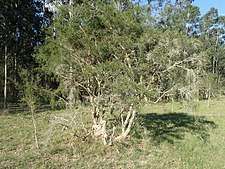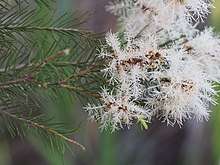Melaleuca alternifolia
Melaleuca alternifolia, commonly known as tea tree,[2] is a species of tree or tall shrub in the myrtle family, Myrtaceae. Endemic to Australia, it occurs in southeast Queensland and the north coast and adjacent ranges of New South Wales where it grows along streams and on swampy flats, and is often the dominant species where it occurs.

| Tea tree | |
|---|---|
 | |
| Melaleuca alternifolia growing near Casino | |
| Scientific classification | |
| Kingdom: | Plantae |
| Clade: | Tracheophytes |
| Clade: | Angiosperms |
| Clade: | Eudicots |
| Clade: | Rosids |
| Order: | Myrtales |
| Family: | Myrtaceae |
| Genus: | Melaleuca |
| Species: | M. alternifolia |
| Binomial name | |
| Melaleuca alternifolia | |
Description
Melaleuca alternifolia is a small tree to about 7 m (20 ft) with a bushy crown and whitish, papery bark. The leaves are arranged alternately, sometimes scattered or whorled. The leaves are smooth, soft, linear in shape, 10–35 mm (0.4–1 in) long and 1 mm (0.04 in) wide. They are also rich in oil with the glands prominent. Flowers occur in white or cream-colored masses of spikes 3–5 cm (1–2 in) long over a short period, mostly spring to early summer, and give the tree an appearance of looking fluffy. The small woody, cup-shaped fruit, 2–3 mm (0.08–0.1 in) in diameter are scattered along the branches.[2][3]
Taxonomy and naming
Melaleuca alternifolia was first formally described in 1905 by Joseph Maiden and Ernst Betche as Melaleuca linariifolia var. alternifolia. The description was published in Proceedings of the Linnean Society of New South Wales[4][5] but was renamed Melaleuca alternifolia in 1925 by Edwin Cheel.[1][6] The specific epithet (alternifolia) is derived from the Latin alternus meaning "alternate" and folium meaning "leaf", referring to the leaf arrangement.[7]
Distribution and habitat
Melaleuca alternifolia is endemic to Australia and is found from the Grafton district in New South Wales as far inland as Stroud and north to Maryborough in Queensland.[8] It grows along streams and in swampy places.[3][9]
Uses
Horticulture
This species grows well in a wide range of soils and climates. It prefers well-drained but moist soils and to be grown in full sun.[3]
Medicinal uses
Tea tree has been used as an alternative medicinal treatment for almost a century in Australia.[10] Indigenous Australians of eastern inland areas use "tea trees" as a traditional medicine by inhaling the oils from the crushed leaves to treat coughs and colds. They also sprinkle leaves on wounds, after which a poultice is applied. In addition, tea tree leaves are soaked to make an infusion to treat sore throats or skin ailments.[11][12]
Characteristic of the myrtle family Myrtaceae, it is used to distill essential oil. It is the primary species for commercial production of tea tree oil (melaleuca oil), a topical antibacterial.[13] Tea tree oil is commonly used as a topical antiseptic agent because of its antimicrobial properties, especially in the treatment of acne.[14] It is also known to reduce inflammation and may be effective in the treatment of fungal infections such as Athlete's foot.[15]
Tea tree oil should not be ingested in large amounts due to its toxicity and may cause skin irritation if used topically in high concentrations.[16] No deaths have been reported in medical literature.[16]
Gallery
.jpg)
 M. alternifolia fruits
M. alternifolia fruits M. alternifolia bark
M. alternifolia bark_tree.jpg) M. alternifolia tree
M. alternifolia tree_flowers.jpg) M. alternifolia flowers
M. alternifolia flowers
References
- "Melaleuca alternifolia". APNI. Retrieved 4 March 2015.
- "Melaleuca alternifolia". Royal Botanic Garden Sydney. Retrieved 13 December 2018.
- Holliday, Ivan (2004). Melaleucas : a field and garden guide (2nd ed.). Frenchs Forest, N.S.W.: Reed New Holland Publishers. pp. 16–17. ISBN 1876334983.
- "Melaleuca linariifolia var. alternifolia". APNI. Retrieved 4 March 2015.
- Maiden, Joseph; Betche, Ernst (1905). "Notes from the Botanic Gardens, Sydney No. 10". Proceedings of the Linnean Society of New South Wales. 29 (4): 742. Retrieved 13 December 2018.
- Cheel, Edwin (1924). "Notes on Melaleuca with descriptions of two new species and a new variety". Journal and Proceedings of the Royal Society of New South Wales. 58: 195.
- Brophy, Joseph J.; Craven, Lyndley A.; Doran, John C. (2013). Melaleucas : their botany, essential oils and uses. Canberra: Australian Centre for International Agricultural Research. p. 73. ISBN 9781922137517.
- Carson, C. F.; Hammer, K. A.; Riley, T. V. (2006-01-01). "Melaleuca alternifolia (Tea Tree) Oil: a Review of Antimicrobial and Other Medicinal Properties". Clinical Microbiology Reviews. 19 (1): 50–62. doi:10.1128/CMR.19.1.50-62.2006. ISSN 0893-8512. PMC 1360273. PMID 16418522.
- "Melaleuca alternifolia". Royal Botanic Gardens, Sydney. Retrieved 4 March 2015.
- "Why tea tree oil deserves a spot in your skincare and hair care regimen". VOGUE India. 2019-01-23. Retrieved 2019-02-21.
- Shemesh, A.; Mayo, W. L. (1991). "Australian tea tree oil: a natural antiseptic and fungicidal agent". Aust. J. Pharm. 72: 802–803.
- Low, T. 1990. Bush medicine. Harper Collins Publishers, North Ryde, NSW, Australia
- Carson, C. F.; Hammer, K. A.; Riley, T. V. (2006). "Melaleuca alternifolia (Tea Tree) Oil: a Review of Antimicrobial and Other Medicinal Properties". Clinical Microbiology Reviews. 19 (1): 50–62. doi:10.1128/CMR.19.1.50-62.2006. PMC 1360273. PMID 16418522.
- Bassett, I. B.; Pannowitz, D. L.; Barnetson, R. S. (1990). "A comparative study of tea-tree oil versus benzoylperoxide in the treatment of acne". The Medical Journal of Australia. 153 (8): 455–8. doi:10.5694/j.1326-5377.1990.tb126150.x. PMID 2145499.
- "Tea tree oil". U.S. National Library of Medicine. Retrieved 26 December 2015.
- Hammer, K; Carson, C; Riley, T; Nielsen, J (2006). "A review of the toxicity of Melaleuca alternifolia (tea tree) oil". Food and Chemical Toxicology. 44 (5): 616–25. doi:10.1016/j.fct.2005.09.001. PMID 16243420.